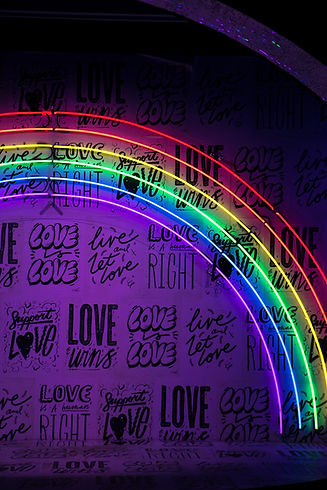PRIDE MONTH
June

LGBT Pride Month is celebrated annually in June to honor the 1969 Stonewall Riots, and works to achieve equal justice and give inspiration to those in the community through recognizing the impact LGBT individuals have had on history. Fortunately, policies are increasingly acknowledging and focusing on LGBT youth. Today, celebrations include pride parades, picnics, parties, workshops, concerts, and other events which attract millions of participants around the world. Memorials are also held for those in the community who have been lost to hate crimes or HIV/AIDS.
SHOWING YOUR PRIDE
Unfortunately, not every day can be a pride fest- it isn’t always glitter, short shorts, and rainbow boas. It can be tiresome, impractical, and even dangerous for some to be out and proud all the time. It’s important to remember that pride isn’t just about a parade in the month of June-it’s also a state of mind. Here’s 5 ways to show your LGBT love in everyday life:



WEAR QUIET RAINBOWS
Since it’s not always appropriate for some to be sporting gay attire (such as if they work in a place with a dress code that doesn’t allow much individuality), some choose to instead wear something more subliminal, such as a rainbow watch band, a rainbow lanyard, or an LGBT button. Options such as these are quiet, yet also let the community know that you’re proud to be yourself.
HAVE A MOVIE NIGHT
Though there’s not many, hit films such as "Love, Simon" feature LGBT individuals as the main characters. Other movies and shows that depict LGBT culture in a positive light are "Paris is Burning" and "Queer Eye". GLAAD, the Gay & Lesbian Alliance Against Defamation, also offers positive suggestions.
VISIT LOCAL GAY ESTABLISHMENTS
If going out is your thing, you can be a patron of a local gay club yourself. If drinking isn’t your thing (or you’re underage), there are also cafes that operate the same way. By patronizing these places, you’re letting them know that they’re needed and loved, as well as keeping them in business. Many also employ LGBT people to work there. Unfortunately, places such as these are also hard to find.



HELP ORGANIZATIONS IN NEED
Unfortunately, pride isn’t just about parties and fashion; it’s also about helping to take care of members in the community who are in need. Organizations out there fighting for LGBT equality need your help, such as the Anti-Violence Project, Human Rights Campaign, Sylvia Rivers Law Project, GLAAD, the National LGBTQ Task Force, Immigration Equality, Service & Advocacy for GLBT Elders (SAGE), the Transgender Law Center, and The Association of LGBTQ Journalists. Some others in America are the Los Angeles LGBT Center, Equality North Carolina, and the Howard Brown Health Center.
GET INFORMED AND SUPPORT LGBT ARTISTS
If you can’t do something as big as helping one of those organizations, whether you don’t have the time, money, or you yourself aren’t in a safe position to do so, many other options are available for you to help out. When you go out of your way to listen to LGBT artists, consume art created by LGBT creators, and learn LGBT history, you contribute to the collective pride. The more you learn, the more you’ll be able to stand up for the community.
STONEWALL RIOTS
"The first pride was a riot"

THE LAW
The 1960s and previous years had not been accepting of LGBT Americans. Any act of having same-sex relations was illegal, even in New York City. For this reason, many gathered at bars and clubs, where they could express themselves openly. However, the New York State Liquor Authority penalized and shut down establishments that served alcohol to known or even suspected LGBT individuals, arguing that even their gathering was “disorderly”. Thanks to activists, these regulations were overturned in 1966 and LGBT patrons could then be served alcohol. However, since engaging in gay behavior was still illegal, police harassment continued.
THE BAR
Many establishments operated without liquor licenses-partly because they were owned by the Mafia. The Genovese family purchased Stonewall Inn, a “straight” bar, which they cheaply renovated and reopened as a gay bar. It was registered as a “bottle bar”, meaning they didn’t require a liquor license because patrons were to bring their own liquor. They had to sign their names upon entry to maintain the club’s false exclusivity. The Genovese family bribed the NYPD to ignore the activities occurring within the club. Stonewall Inn quickly became an important place to many LGBT individuals. It was a home for runaways and homeless gay youths. It was one of the few, if not only, gay bars that allowed dancing. It even welcomed drag queens, who received extra hatred at other gay bars.


THE RIOT
When police raided the morning of June 28, it came as a surprise. Armed with a warrant, officers aggressively manhandled patrons and arrested 13 people (including employees and cross-dressers). At one point, an officer even hit a lesbian as he forced her into his car. Cross dressers and trans people who violated the states' gender appropriate clothing statue were taken into the bathroom to check their sex. Fed up with constant police harassment, angry patrons and neighborhood residents stayed outside the bar rather than dispersed. Within minutes, a full-blown riot involving hundreds of people began. The police, a few prisoners, and a journal writer barricaded themselves inside the bar, which led to the mob attempting to set fire to the Inn. The fire department was able to disperse the flames, rescue those inside Stonewall, and disperse the crowd. However, protests involving thousands of people continued for five more days.
ACTIVISM
Though the Stonewall movement didn't start the gay rights movement, it was a huge act of empowerment for LGBT activism, which led to numerous gay rights organizations. In 2016, President Barack Obama designated the site-Stonewall Inn, Christopher Park, and the surrounding streets and sidewalks-a national monument in recognition of the area's contribution to LGBT rights.
